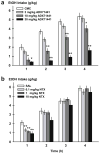Reduction of excessive alcohol drinking by a novel GABAB receptor positive allosteric modulator ADX71441 in mice
- PMID: 23975038
- PMCID: PMC3947346
- DOI: 10.1007/s00213-013-3245-z
Reduction of excessive alcohol drinking by a novel GABAB receptor positive allosteric modulator ADX71441 in mice
Abstract
Rationale: A promising pharmacotherapy for alcohol use disorders has been positive allosteric modulators (PAMs) of the γ-aminobutyric acid receptor B (GABAB R) since GABAB R PAMs reduce ethanol drinking and self-administration in rodents.
Objective: The current studies investigated a novel, selective GABAB R PAM, ADX71441, in comparison to naltrexone in a protocol of ethanol binge-like drinking, drinking-in-the-dark (DID), and in a model of long-term, excessive drinking, intermittent access to ethanol (IA).
Methods: Male C57BL/6 J mice were given doses of ADX71441 (3, 10, 30 mg/kg, p.o.) before the fourth test day of repeated DID access to 20 % ethanol. Another group of mice had a history of 4 weeks of IA before ADX71441 (3, 10, 17 mg/kg, p.o.) treatment. The opioid antagonist, naltrexone (0.1, 1, 10 mg/kg, i.p.), was administered to different groups of mice in both protocols as a positive control.
Results: In both DID and IA protocols, ADX71441 showed a selective and potent reduction of ethanol drinking, but not water drinking, while naltrexone had a more modest and transient effect on reducing ethanol drinking. The long-lasting effect of ADX71441 agrees with its plasma pharmacokinetics in showing peak concentrations at 2 h followed by a slow decay lasting well beyond 8 h.
Conclusions: These findings support previous studies demonstrating that GABAB R PAMs decrease voluntary ethanol intake without altering water intake. ADX71441 may be a worthwhile candidate for developing a treatment of alcoholism, yet its site of action in the brain and long-term pharmacological effects require further exploration.
Figures




Similar articles
-
Recent Advances in the Potential of Positive Allosteric Modulators of the GABAB Receptor to Treat Alcohol Use Disorder.Alcohol Alcohol. 2021 Feb 24;56(2):139-148. doi: 10.1093/alcalc/agab003. Alcohol Alcohol. 2021. PMID: 33561865 Free PMC article. Review.
-
The GABAB Positive Allosteric Modulator ADX71441 Attenuates Alcohol Self-Administration and Relapse to Alcohol Seeking in Rats.Neuropsychopharmacology. 2017 Aug;42(9):1789-1799. doi: 10.1038/npp.2017.53. Epub 2017 Mar 15. Neuropsychopharmacology. 2017. PMID: 28294133 Free PMC article.
-
The drug candidate, ADX71441, is a novel, potent and selective positive allosteric modulator of the GABAB receptor with a potential for treatment of anxiety, pain and spasticity.Neuropharmacology. 2017 Mar 1;114:34-47. doi: 10.1016/j.neuropharm.2016.11.016. Epub 2016 Nov 23. Neuropharmacology. 2017. PMID: 27889489
-
ADX71943 and ADX71441, novel positive allosteric modulators of the GABAB receptor with distinct central/peripheral profiles, show efficacy in the monosodium iodoacetate model of chronic osteoarthritis pain in the rat.Eur J Pharmacol. 2017 Jan 15;795:43-49. doi: 10.1016/j.ejphar.2016.11.056. Epub 2016 Dec 1. Eur J Pharmacol. 2017. PMID: 27916555
-
Positive allosteric modulators of the GABAB receptor: a new class of ligands with therapeutic potential for alcohol use disorder.Alcohol Alcohol. 2024 Mar 16;59(3):agae018. doi: 10.1093/alcalc/agae018. Alcohol Alcohol. 2024. PMID: 38566580 Review.
Cited by
-
Reducing effect of the novel positive allosteric modulator of the GABAB receptor, COR659, on binge-like alcohol drinking in male mice and rats.Psychopharmacology (Berl). 2022 Jan;239(1):201-213. doi: 10.1007/s00213-021-06022-3. Epub 2021 Nov 23. Psychopharmacology (Berl). 2022. PMID: 34812900
-
Building better strategies to develop new medications in Alcohol Use Disorder: Learning from past success and failure to shape a brighter future.Neurosci Biobehav Rev. 2019 Aug;103:384-398. doi: 10.1016/j.neubiorev.2019.05.014. Epub 2019 May 18. Neurosci Biobehav Rev. 2019. PMID: 31112713 Free PMC article. Review.
-
ADX71441, a novel, potent and selective positive allosteric modulator of the GABA(B) receptor, shows efficacy in rodent models of overactive bladder.Br J Pharmacol. 2014 Feb;171(4):995-1006. doi: 10.1111/bph.12517. Br J Pharmacol. 2014. PMID: 24224799 Free PMC article.
-
Recent Advances in the Potential of Positive Allosteric Modulators of the GABAB Receptor to Treat Alcohol Use Disorder.Alcohol Alcohol. 2021 Feb 24;56(2):139-148. doi: 10.1093/alcalc/agab003. Alcohol Alcohol. 2021. PMID: 33561865 Free PMC article. Review.
-
Alcohol dependence and free-choice drinking in mice.Alcohol. 2014 May;48(3):287-93. doi: 10.1016/j.alcohol.2013.11.006. Epub 2014 Jan 18. Alcohol. 2014. PMID: 24530006 Free PMC article. Review.
References
-
- Addolorato G, Leggio L. Safety and efficacy of baclofen in the treatment of alcohol-dependent patients. Current pharmaceutical design. 2010;16(19):2113–2117. - PubMed
-
- Addolorato G, Caputo F, Capristo E, Demonicali M, Bernardi M, Janiri L, Agabio R, Colombo G, Gessa GL, Gasbarrini G. Baclofen efficacy in reducing alcohol craving and intake: a preliminary double-blind randomized controlled study. Alcohol and Alcoholism. 2002;37(5):504–508. - PubMed
-
- Addolorato G, Leggio L, Ferrulli A, Cardone S, Vonghia L, Mirijello A, Abenavoli L, D’Angelo C, Caputo F, Zambon A, Haber PS, Gasbarrini G. Effectiveness and safety of baclofen for maintenance of alcohol abstinence in alcohol-dependent patients with liver cirrhosis: randomised, double-blind controlled study. Lancet. 2007;370(9603):1915–1922. - PubMed
-
- Anstrom KK, Cromwell HC, Markowski T, Woodward DJ. Effect of baclofen and alcohol and sucrose self-administration in rats. Alcohol Clin Exp Res. 2003;27(6):900–908. - PubMed
-
- Anton RF, O’Malley SS, Ciraulo DA, Cisler RA, Couper D, Donavan DM, Gastfriend DR, Hosking JD, et al. Combined pharmaco-therapies and behavioral interventions for alcohol dependence. JAMA. 2006;295(17):2003–2017. - PubMed
Publication types
MeSH terms
Substances
Grants and funding
LinkOut - more resources
Full Text Sources
Other Literature Sources
Medical
Miscellaneous

